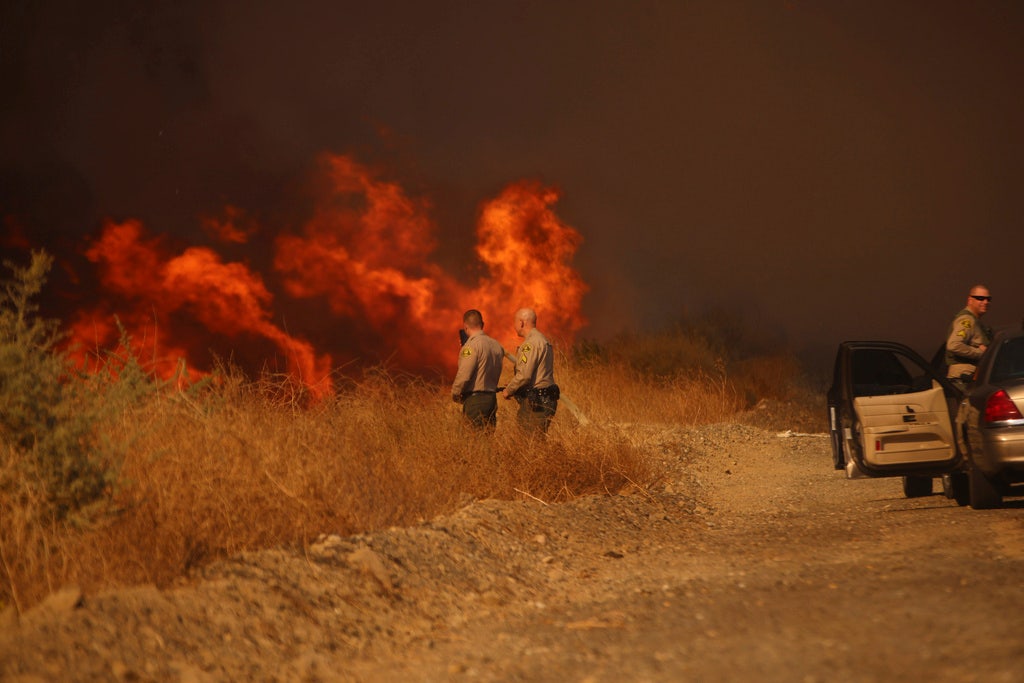The Hughes Fire, a rapidly spreading wildfire in Castaic, Los Angeles County, has triggered a large-scale evacuation effort, including the partial evacuation of the Pitchess Detention Center, a jail complex housing approximately 5,000 inmates. The fire, which ignited on Wednesday afternoon, quickly consumed nearly 9,300 acres, fueled by dry conditions and driven by strong winds. Despite the efforts of 4,000 firefighters, the fire remained uncontained, forcing over 50,000 residents to flee their homes, alongside almost 500 inmates from one of the Pitchess Detention Center’s three facilities. Sheriff Robert Luna confirmed the inmates were relocated to another facility within the jail complex. The situation remains precarious, with the potential for further evacuations if the fire continues to threaten the remaining jail facilities.
The evacuation of the Pitchess Detention Center highlights the complex challenges posed by wildfires in densely populated areas. The jail’s proximity to the fire’s path necessitated the rapid relocation of inmates, a logistical undertaking requiring careful planning and execution. While the immediate priority was ensuring the safety of both inmates and staff, the evacuation also underscores the vulnerability of incarcerated populations during emergencies. Sheriff Luna acknowledged having a contingency plan in place to evacuate the entire jail complex, housing over 4,500 inmates, if the fire’s progression demanded such action. This underscored the potential magnitude of the disaster and the strain it could place on resources.
In a remarkable show of resilience and community spirit, a group of inmates from the Pitchess Detention Center joined the frontline efforts against the Hughes Fire. These inmate firefighters, trained and equipped to combat wildfires, played a crucial role in containing the blaze and protecting surrounding properties. Damien Brown, an inmate firefighter who also participated in battling the previous Palisades Fire, shared his experience battling the flames and expressed his empathy for the displaced residents. Their involvement demonstrated a powerful example of rehabilitation and community contribution, even in the face of adversity. Their efforts highlighted the potential for positive contributions from individuals often marginalized within society.
The unfolding situation at the Pitchess Detention Center sparked urgent calls for action from advocacy groups concerned about the safety and well-being of the incarcerated population. The L.A. County Public Defender’s Union, Los Angeles People’s City Council, and Justice LA voiced their concerns on social media, demanding immediate action from authorities to ensure the safety of the inmates. They criticized the perceived delayed response and expressed apprehension about the logistical feasibility of evacuating the entire jail population if necessary. These concerns highlighted the potential human cost of the fire and the responsibility of authorities to protect vulnerable populations under their care.
The gravity of the Hughes Fire prompted a large-scale aerial response, including the deployment of all eight available MAFFS (Modular Aerial Firefighting System) aircraft in the United States. These aircraft, equipped to drop large quantities of fire retardant, played a crucial role in combating the fire’s spread. Two of these aircraft belonged to the California Air National Guard, while the remaining six were pre-positioned in response to the earlier Palisades and Eaton Fires, illustrating the interconnectedness of wildfire management efforts across the state. Governor Gavin Newsom pledged continued support and resources to combat the fire, highlighting the state’s commitment to addressing the ongoing wildfire crisis.
The Hughes Fire represents another challenging chapter in California’s ongoing struggle with wildfires. The rapid spread of the fire, fueled by dry vegetation and driven by strong winds, underscored the vulnerability of communities to these devastating events. The evacuation of thousands of residents, along with a significant portion of the Pitchess Detention Center, highlighted the complex logistical challenges of managing large-scale evacuations. The involvement of inmate firefighters showcased the potential for positive contributions from often marginalized communities, while the advocacy efforts of organizations underscored the importance of protecting vulnerable populations during emergencies. The deployment of significant aerial resources demonstrated the scale and seriousness of the firefighting effort and the state’s commitment to protecting lives and property.

